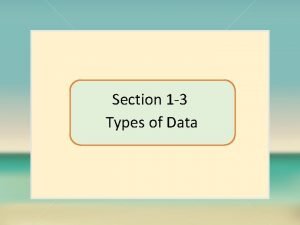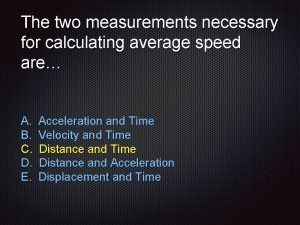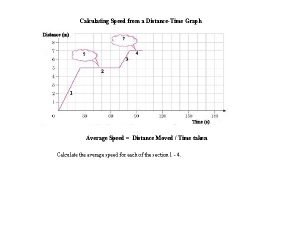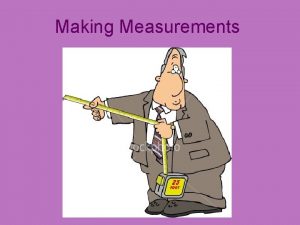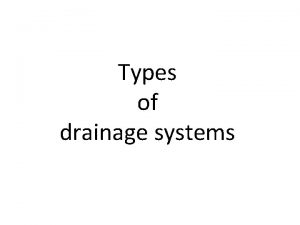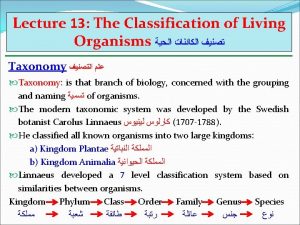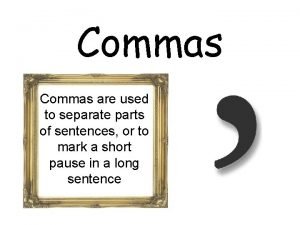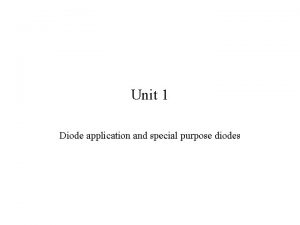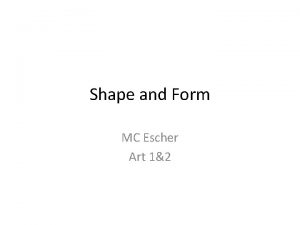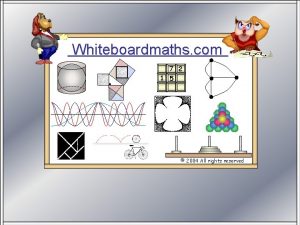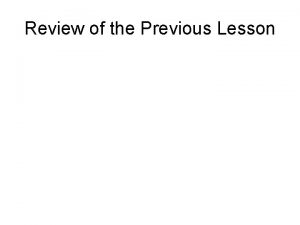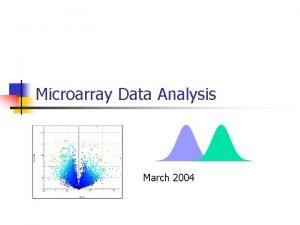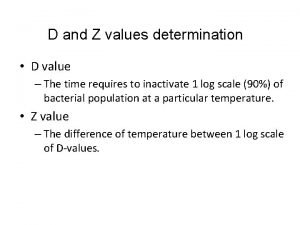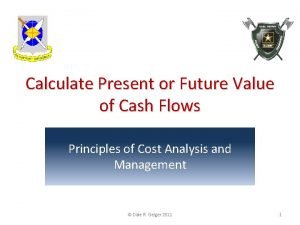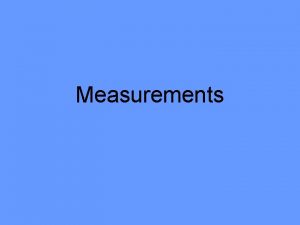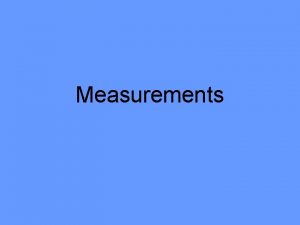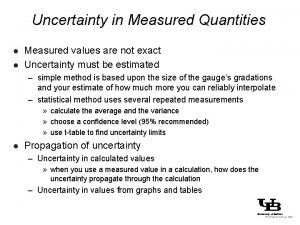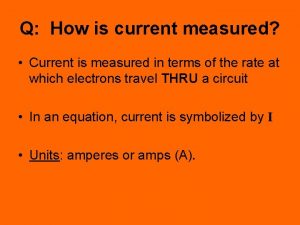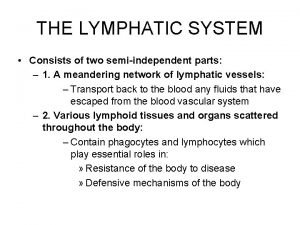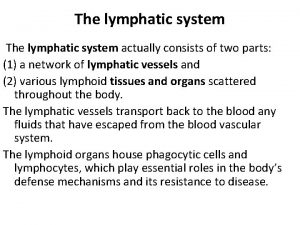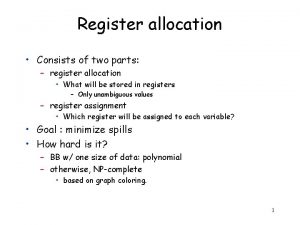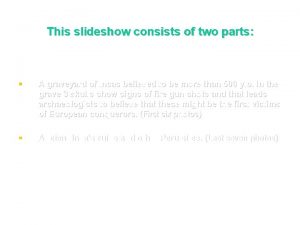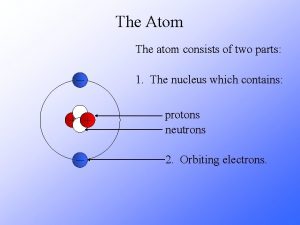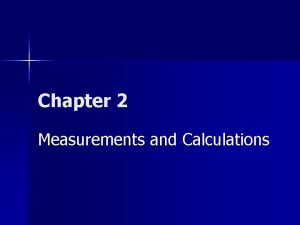Measurements Any measured value consists of two parts


































- Slides: 34


Measurements Any measured value consists of two parts: a number and the units. The number tells: the magnitude of the measurement, the precision of the measurement. The units tells what property is being measured, such as mass, length, temperature, velocity. .

In science (and most of the modern world) we use the SI system of measurements. The SI system makes working with very large and small values much simpler than the Imperial System we use in the US. Instead of having to convert between inches, feet, and miles, or ounces, pints and quarts, the SI units are related by powers of 10.

The SI units we will be using this semester include: Base quantity length mass time temperature Unit meter gram (kilogram) second Kelvin energy joule volume liter = (0. 1 m)3 number (6. 022 E 23) mole Abbreviation m g kg s K J L mol

Prefixes are used with the units when working with larger or smaller quantities. Some of the more common prefixes are: Prefix Giga Mega kilo deci centi milli micro nano Abbreviation G M k d c m µ n multiplication factor 1 E 9 = 1 billion 1 E 6 = 1 million 1 E 3 = 1000 1 E-1 = 0. 1 1 E-2 = 0. 01 1 E-3 = 0. 001 1 E-6 = 1 millionth 1 E-9 = 1 billionth


The prefix is placed before the base unit. This multiplies the base unit and creates a new larger or smaller unit. 1 m = 1 meter 1 km = 1 * 1000 * m = 1000 meters 1 nm = 1 * 1 E-9 * m = 0. 00001 meters

Mass All matter has mass ●Mass is independent of gravity (weight is the product of mass and the earths gravity) ● A dime has a mass of a little more than 2 grams ●There are 2. 2 lbs in one kg ●

Length ● The SI unit for length is the meter ● One meter is a little longer than a yard ● One mile is about 1. 6 km ● The diameter of a dime is a little less than 2 cm ● The thickness of a dime is a little more than 1 mm ● The diameter of an atom is 0. 1 -10 nm

Volume The liter is a derived unit since it is based on the meter: Volume = length x width x height Liter = 0. 1 m * 0. 1 m One liter is a little more than a quart 1 m. L = 0. 001 L = 1 cm x 1 cm = 1 cm 3 = 1 m. L = 1 cc (cubic centimeter) The mass of 1 m. L of water is 1 gram


Temperature The Kelvin scale is an absolute temperature scale ● 0 K is the coldest temperature possible ● Water freezes at 273 K ● Water boils at 373 K ●The Centigrade (or Celsius) scale is related to Kelvin by: Kelvin = Centigrade + 273 ● So water freezes at 0 °C ● and water boils at 100 °C ●


Mole A mole is a very large number 1 mole = 6. 022 E 23 ●Moles are useful when counting atoms, molecules, or sub atomic particles ●Think of a mole as we do with other abbreviations 1 dozen = 12 1 gross = 144 1 thousand = 1000 1 mole = 6. 022 E 23 ● 1 mole of hydrogen atoms has a mass of 1 gram

Accuracy, Precision and Significant Figures Accuracy ● How close a measurement is to the true value. ● Several measurements are often averaged to improve the accuracy. Precision ● How close several measurements are to each other. ● A more precise instrument will measure in smaller increments.


Measurements using equipment with smaller gradients are more precise. ● When using analog scales, the last digit of precision is estimated between the finest gradients. ● ● e. g. if the smallest markings on a ruler are in cm, then the length should be estimated to mm.



Significant Figures Significant figures are used to indicate the precision of a measurement or calculation. The number of significant figures in a measurement depends on: The object being measured. The precision of the instrument. All values should show the proper significant figures.

To demonstrate the value of sig. figs. , consider buying one gallon of gas for your car: If the pump only measures to 1 gallon of precision: this 1 gal could be 0. 5 gal or 1. 49 gal If the pump measures to 0. 1 gallon precision: then this 1. 0 gal could be 0. 95 gal or 1. 049 gal If the pump measures to 0. 01 gallon precision: then this 1. 00 gal could be 0. 995 gal or 1. 0049 gal

To determine the correct number of sig. figs. : ● All non-zero digits are significant ● Leading zeros (to the left) are never significant Trapped zeros (between two non-zero digits) are always significant ● Trailing zeros (to the right) are significant if a decimal is present in the number ●

When multiplying/dividing, the answer has the same number of sig. figs. as the initial value with the least sig. figs. 2. 35 g * 1. 2 g = 2. 8 g 2 (3 s. f. ) (2 s. f. ) 8. 22 mm / 1. 00001 mm = (3 s. f. ) (6 s. f. ) 8. 22 (3 s. f. )

When adding/subtracting values, the answer has the same precision as the least precise value. : 9. 2 g + 3. 1 g = (2 s. f. ) 22. 6 L (3 s. f. ) 12. 3 g (3 s. f. ) 21. 633 L = 1. 0 L (5 s. f. ) (2 s. f. ) Note that the answer can have more or less sig. figs. than the initial values when adding/subtracting.


Conversions We often need to change values from one unit to another. To do this, we multiply the initial value by a conversion factor. Conversion factors are ratios of the desired and initial units. Conversion factors equal 1, and so the magnitude of the initial value is not changed.

Most conversion factors come from equalities: e. g. to convert 2. 55 m to mm, we use the definition of mm: 1 mm = 1 E-3 m so to convert the values:

To convert 9. 33 E 2 g to cg: Start with the initial value. 9. 33 E 2 g 1 cg 1 E-2 g 9. 33 E 4 cg Place units in the c. f. to cancel original units. Place units in the c. f. to obtain desired units. Place numbers in the c. f. to make the top and bottom of the factor equal to each other. Complete the calculation, canceling units.

Metric Conversions

Sig. Figs and Conv. Factors Conversion factors based on defined relationships are considered exact and have infinite sig. figs. : 12 in. = 1 ft. 1 km = 1 E 3 m 1 c. L = 1 E-2 L For measured relationships, the sig. figs. depend on the precision of the measurements: 1. 00 in. = 2. 54 cm (3 sig. figs. ) but you may see this written improperly as: 1 in. = 2. 54 cm here '1 in' is considered exact, but '2. 54 cm' has only 3 sig. figs.

Density ● Density is the ratio of mass to volume Density is an intrinsic property. ● At a given temperature, the density if a substance is a constant and does not depend on how much of the substance is present. ● But density can change with temperature. ●For most pure substances: ● The solid form is more dense than the liquid ● The liquid form is more dense than the gas ●

Less dense objects float in more dense media: Water has a density of 1. 00 g/m. L ●Many plastics are less dense than water and will float. ●Iron is more dense than water and will sink. ●An iron boat, however, has a lower average density than water due to the air in the boat. This is why the boat floats unless it is filled with water. ● A piece of rubber will not float in air. ●But a helium balloon will float due to helium lowering the average density of the balloon below that of air. ●

The equation D = m/V may be solved algebraically for the unknown variable. e. g. what is the density of an object if a 25 m. L sample has a mass of 45 grams?

Since density is a constant (for a pure substance at a constant temperature), it may also be used to 'convert' between mass and volume: e. g. what is the volume of 14. 0 g of iron? The density of iron is 0. 444 g/m. L. 14 g 1 m. L 0. 444 g 31. 5 m. L
 It consists of numbers representing counts or measurements
It consists of numbers representing counts or measurements Hair composition
Hair composition Type of body hair
Type of body hair Apa itu value creation
Apa itu value creation The two measurements necessary for calculating speed are
The two measurements necessary for calculating speed are How to calculate average speed from a velocity time graph
How to calculate average speed from a velocity time graph Two types of measurements
Two types of measurements There is some cake
There is some cake Any to any connectivity
Any to any connectivity Any question atau any questions
Any question atau any questions Great britain consists of three parts
Great britain consists of three parts Britain consists of
Britain consists of Hci consists of three parts:
Hci consists of three parts: Two pipe system of providing building drainage consists of
Two pipe system of providing building drainage consists of Order of classification of organisms
Order of classification of organisms Pulmonary ventilation consists of two cyclic phases
Pulmonary ventilation consists of two cyclic phases Commas are used to separate
Commas are used to separate Special purpose diode
Special purpose diode A two-dimensional area with a recognizable boundary
A two-dimensional area with a recognizable boundary Secondary education commission (1952-53)
Secondary education commission (1952-53) Role of industrial estates
Role of industrial estates Objectives of industrial estates
Objectives of industrial estates Different method of size separation or
Different method of size separation or Aim of rch programme
Aim of rch programme What is nature and scope of psychology
What is nature and scope of psychology Department account format
Department account format Name any two attributes of body tag.
Name any two attributes of body tag. Any number that can be expressed as a ratio of two integers
Any number that can be expressed as a ratio of two integers Language
Language Circle parts
Circle parts Account payable current or noncurrent
Account payable current or noncurrent T test p value interpretation
T test p value interpretation D value and z value
D value and z value Acetyl value principle
Acetyl value principle Present value table
Present value table
